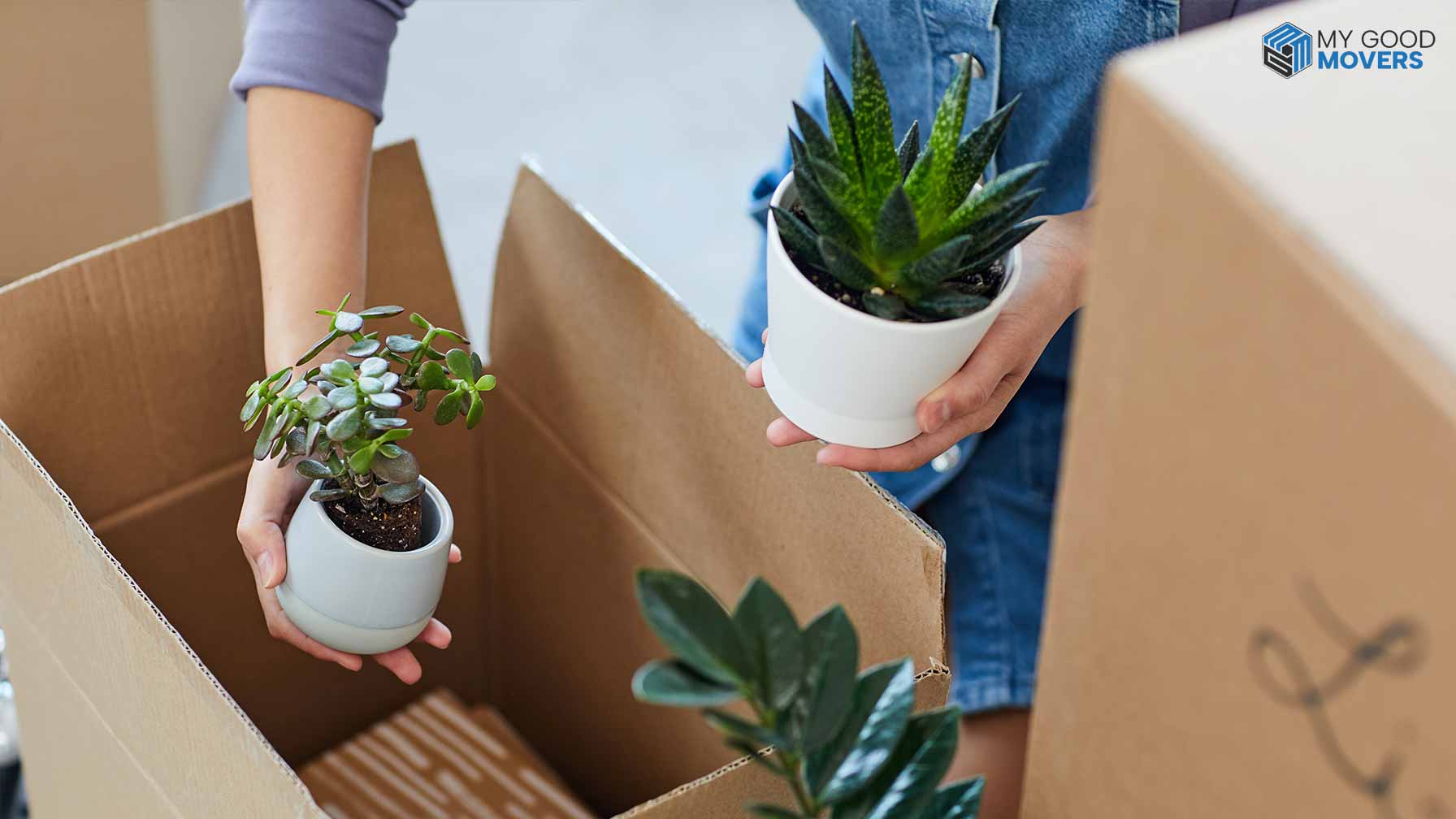Some people view plants as mere decoration, while others care for them as they would their own children. Whatever the underlying reason, one thing always remains constant: the need to pack them safely. This raises the question: How to pack plants for moving?
These living, breathing companions add life to your home, and ensuring they arrive safely at your new location requires special care.
Moving can be a bumpy road, and your plants are particularly vulnerable to the stress of the journey. Whether it's the scorching sun or a few too many bumps in the road, moving plants requires more than just tossing them in a box.
But fear not! With the right moving tips, you can ensure your green companions weather the storm and continue to bloom in your new home.
Not Sure When to Start Packing for Your Move? Read When Should You Start Packing to Move to Find Out the Best Time to Begin for a Smooth and Easy Move!
How to Safely Pack Indoor Plants for Moving
Let's check some variables to see how you can safely pack indoor plants for moving.
1. Assess the Health of Your Plants
Before packing, inspect your indoor plants for any signs of disease or pests. Trim dead or damaged leaves, and if necessary, repot them into plastic containers to make the move easier. Healthy plants are more likely to survive the stress of moving.
2. Gather the Right Supplies
To properly pack your plants, you’ll need a few essential items:
Curious about your moving costs? Fill out the details, and we’ll calculate them for you.

-
Sturdy boxes
-
Plastic pots (if your plants are in breakable containers)
-
Packing paper or newspaper
-
Bubble wrap
-
Moisture-proof packing material

Plants are vital for life on Earth as they produce oxygen through photosynthesis, converting carbon dioxide and sunlight into oxygen and glucose.
3. Water Your Plants Appropriately
Knowing how to pack plants for moving includes understanding their watering needs. Water your plants a couple of days before the move. This ensures the soil is damp but not soggy, reducing the risk of mold or root rot during transit.
4. Secure the Plants in Boxes
Line the bottom of the boxes with bubble wrap or packing paper to cushion the plants. Place each plant in a box and fill in any gaps with crumpled paper to prevent shifting. If your plants are tall, wrap the foliage lightly with newspaper to protect the leaves. Label the boxes as "Fragile" and "This Side Up" to ensure careful handling.
5. Provide Proper Ventilation
Don't forget about ventilation when learning how to pack plants for moving. Poke small holes in the sides of the boxes to allow air circulation. This is especially important for longer moves where the plants will be boxed up for an extended period.
6. Handle with Care During Transit
Place the boxes in a stable area of your vehicle, away from direct sunlight and extreme temperatures. Transport the plants in your car rather than the moving truck if possible. This gives you better control over their environment and reduces the risk of damage.
7. Unpack and Reacclimate Your Plants
Once you arrive at your new home, unpack your plants immediately. Place them in a spot with similar lighting conditions to their previous location, and gradually adjust their watering schedule as they settle into their new environment.
Sometimes, you might need to hire a moving company to safely transport your plants. Read Moving Labor - Affordable and Safe Moving Solutions Near You

Scientists estimate that there are more than 400,000 plant species on Earth, with a wide range of shapes, sizes, and adaptations.
Best Packing Techniques for Outdoor Plants When Moving
Moving your outdoor plants can feel like a monumental task, especially when you’ve nurtured your garden to perfection. Learning how to pack plants for moving is essential to ensure they survive the journey and continue to thrive in your new home.
Below are the best techniques to pack your outdoor plants safely and efficiently, ensuring they arrive healthy and ready to grow.
Prune and Prepare Your Plants
Start by pruning your outdoor plants to remove dead or damaged branches. This step not only reduces the size of the plants but also promotes healthier growth after replanting.
Additionally, remove weeds and give your plants a thorough watering a few days before the move to ensure they’re well-hydrated.
Choose the Right Time to Move
Timing is crucial when moving outdoor plants. Aim to move them during the cooler parts of the day, such as early morning or late afternoon. This reduces the risk of heat stress, especially if you’re moving in hot weather conditions.
If possible, avoid moving during extreme weather, whether it’s too hot, cold, or during heavy rain.
Use Durable and Appropriate Containers
Transfer them to sturdy, lightweight containers for larger outdoor plants to make them easier to move. Plastic pots are a great option as they are more durable during transport than ceramic pots, which can easily break.
Affordable moving containers designed specifically for plants can be found at most garden centers. These containers provide extra protection during the move.
Wrap and Protect the Roots
Protecting the roots is a vital step in knowing how to pack plants for moving. Wrap the roots of your outdoor plants in burlap or damp cloths to maintain moisture during transit.
For smaller plants or seedlings, consider using peat pots, which can be planted directly into the soil at your new location.

Certain plants, like the Bristlecone Pine, can live for over 5,000 years, making them some of the oldest living organisms on the planet.
Shield Delicate Plants
For plants with fragile branches or leaves, cover them with breathable fabric or garden netting. This prevents damage from physical impact and keeps them safe from the elements.
If you’re moving during cold weather conditions, extra insulation around the plants can prevent frost damage.
Pack Plants in Sturdy, Well-Ventilated Boxes
Place your potted outdoor plants in sturdy boxes that can bear their weight without collapsing. Line the bottom of the boxes with crumpled paper or bubble wrap to cushion the plants during transport.
Leave the tops of the boxes open or cut small holes in the sides for ventilation, ensuring your plants can breathe during the journey.
Label and Handle with Care
Label each box clearly with “Fragile” and “This Side Up” to ensure careful handling. This is particularly important if you’re using a professional moving company, as it alerts them to handle these boxes with special care.
When loading the plants into your vehicle, secure them in a stable area where they won’t tip over or get crushed by other items.
Replant and Reacclimate Immediately
Upon arrival at your new home, unpack your plants and replant them in their designated spots as soon as possible. If the weather is too extreme, keep them indoors or in a sheltered area until conditions improve.
Water them thoroughly and monitor their progress as they acclimate to their new surroundings.
Consider the Planting Environment
Once you've replanted your outdoor plants, consider their new environment. Check for sunlight, soil, and watering conditions similar to those in their previous location.
This is particularly important for long-distance moves, where climate differences could impact plant health. Adjust your gardening techniques as necessary to help your plants thrive.
Moving Tips for Packing Potted Plants
| Tip | Description |
|---|---|
| Gradually Acclimate Plants | Slowly get your plants used to the moving conditions, like less sunlight or different temperatures, before the move. |
| Secure Loose Soil | Cover the top of each pot with plastic wrap or a cloth to prevent soil from spilling. |
| Group Similar Plants | Put plants with similar needs together in the same box. This makes it easier to care for them, such as watering and temperature control during the move. |
| Use a Dolly for Large Pots | For heavy or large potted plants, use a dolly to move them. |
| Monitor Temperature Changes | Keep an eye on the temperature in your vehicle during the move. Try to maintain a steady environment to avoid shocking your plants. |
| Keep Plants Upright | Make sure pots stay upright during transport. Use boxes with dividers or add crumpled paper around pots to prevent tipping over. |
If you are thinking about moving plants, you will likely need a moving checklist. Read How to Prepare for a Move: Checklist, Tips and More.
How to Transport Delicate Plants During a Move
Transporting delicate plants during a move can feel like walking on eggshells. To keep them safe, start by wrapping their leaves and stems in breathable cloth or garden netting—think of it as giving them a cozy blanket for the trip.
Place each plant in a sturdy box, adding padding like bubble wrap or crumpled paper to prevent bumps and bruises. Statistics show that plants transported in climate-controlled environments are 40% less likely to suffer damage, so try to keep the boxes in a temperature-steady vehicle.
If you handle these boxes with care, your delicate plants will have a much better chance of arriving in one piece.

The largest living plant is a clonal grove of quaking aspen trees in Utah known as Pando, which covers over 106 acres and is estimated to be around 80,000 years old.
What to Do After Unpacking Plants at Your New Home
Normally, you’d think that packing and moving your plants is the hardest part. But here’s the catch: what to do after unpacking them at your new home?
-
Unpack Immediately: Remove plants from boxes as soon as you arrive to minimize stress and damage.
-
Inspect for Damage: Check each plant for any signs of damage or distress. Prune any broken or damaged parts.
-
Re-pot if Needed: If plants were in temporary containers, transfer them to their permanent pots or garden beds.
-
Water Thoroughly: Give each plant a good drink of water to help them adjust and recover from the move.
-
Adjust Light Conditions: Place plants in locations with appropriate light, similar to their previous environment.
-
Monitor for Stress: Keep an eye on your plants for signs of stress or shock, such as drooping leaves or yellowing. Adjust care as needed.
-
Check Soil Moisture: Ensure the soil is neither too dry nor too wet. Adjust watering schedules based on the plant’s needs and local climate.
-
Fertilize Lightly: After a week or so, consider applying a mild fertilizer to help plants regain strength. Avoid heavy feeding right after the move.





